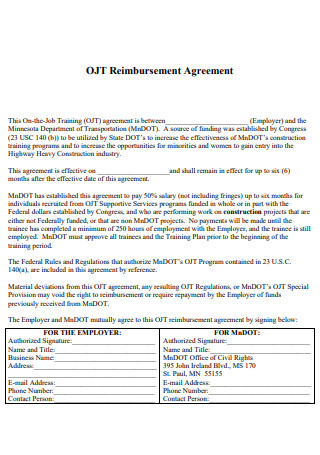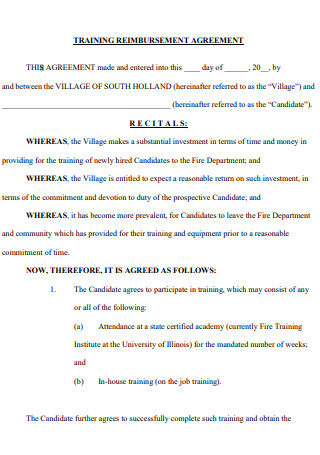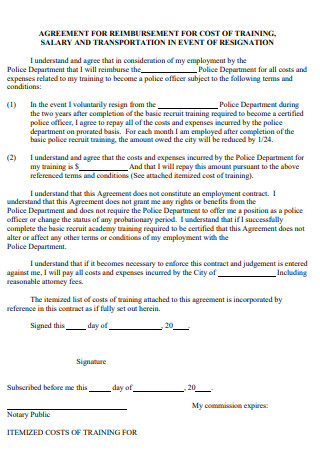16+ SAMPLE Training Reimbursement Agreement
-

On The Job Training Reimbursement Agreement
download now -

Training Reimbursement Agreement
download now -

Simple Training Reimbursement Agreement
download now -

Reimbursement Agreement for Hiring And Training
download now -

Training Wage Reimbursement Agreement
download now -

Fire Department Training Reimbursement Agreement
download now -

Officer Training Reimbursement Agreement
download now -

Police Petrol Training Reimbursement Agreement
download now -

Agreement for Training and Uniform Reimbursement
download now -

Maritime Officers Training Reimbursement Agreement
download now -

education training Reimbursement Agreement
download now -

Training Expense Reimbursement Agreement
download now -

Training Request Reimbursement Agreement
download now -

Training Fund Reimbursement Agreement
download now -

Agreement for Reimbursement for Cost of Training
download now -

Standard Training Reimbursement Agreement
download now -

Paramedic Training Reimbursement Agreement
download now
FREE Training Reimbursement Agreement s to Download
16+ SAMPLE Training Reimbursement Agreement
What Is a Training Reimbursement Agreement?
Benefits of Employee Training
Tips to Train Employees Effectively
How to Create an Expense Reimbursement Policy
FAQs
What are training methods?
What is the impact of training?
What is training in the workplace?
What Is a Training Reimbursement Agreement?
When a corporation conducts a training program or funds an employee’s education, there is a cost involved. Some training may fit inside a budget, but those that exceed the budget will require the management to give a training reimbursement agreement, also known as a training bond agreement. This is an agreement between two groups to reimburse one party for expenses incurred in a particular enterprise. It will specify how much training costs, who is providing it, and who is initially responsible for paying for it. Reimbursement agreements frequently contain specified terms to qualify for reimbursement. Training and development help businesses find and keep the best employees, improve job satisfaction and morale, boost productivity, and make more money. Also, companies with interested and dedicated employees have lower absenteeism rates by 41% and higher productivity by 17%.
Benefits of Employee Training
Training personnel should be at the forefront of the learning initiatives of most firms. You foster an organization-wide learning culture by providing employees with personal and skilled development training opportunities. Employees can acquire various skills to advance their careers, while you gain from greater employee engagement and productivity due to training efforts. Learning improves employees and ultimately benefits the firm. Businesses that develop and implement a robust enterprise learning strategy will receive additional benefits. These advantages extend well beyond predicted advantages, such as enhanced efficiency. In addition to maintaining employee engagement, there are other reasons why firms should implement a robust learning and development strategy. Here are the most significant advantages a firm may anticipate from staff training:
Tips to Train Employees Effectively
After hiring a qualified applicant, the following step is the onboarding procedure, which frequently includes training. This allows you to demonstrate to new employees how to be victorious in their work and assist them in adapting to the company’s culture. You may reduce employee turnover and increase productivity by taking the time to train a team adequately. In this section, we discuss the significance of employee training and present several effective training methods. These are some excellent techniques to train your staff:
1. Focus on hard and soft skills
In addition to focusing on technical skills such as learning programs or software, it is essential to focus on strengthening team members’ soft skills. These abilities allow individuals to collaborate well with others. Find strategies to enhance their critical thinking, problem-solving, communication, and conflict-resolution abilities. You can assist them in becoming more well-rounded employees by highlighting hard and soft skills.
2. Personalize training
Although every employee can understand the company’s policies, you may wish to customize the remainder of their training. Ask a newly hired employee about their favorite learning method throughout the onboarding process. You may discover that some employees prefer to study instructions independently, but others prefer to learn through presentations. You can effectively impart new information by adapting your teaching to their learning style.
3. Use multiple platforms
Providing training on many platforms can enhance the learning experience. To educate staff, combine in-person instruction with internet videos, training manuals, and real-world projects. Employees can absorb the subject and hone their skills by utilizing numerous learning methods. In addition, it can be helpful to give digital tools that employees can use whenever they require assistance. Creating a thorough how-to guide is an excellent strategy for promoting autonomous learning.
4. Employees should train one another
You may be responsible for the initial onboarding process, but you can also delegate some training to other experienced team members. These are employees you have faith will do a fantastic job instructing others. This is particularly useful if they will be working with the new employee. Make it evident to the new employee that they may direct any questions to this leader. Having a peer conduct a portion of the training can make the experience more comfortable.
5. Try interval training
Cross-training an employee in multiple departments may be advantageous depending on the environment. If another employee is absent, it can be beneficial to have versatile employees. Choose abilities that may overlap between two positions while cross-training. This may assist your personnel in becoming more proficient at their primary duties.
How to Create an Expense Reimbursement Policy
All may be equal in love and battle, but expense reimbursement is not. When employees spend their money on your firm, such expenditures become your business expenses. It is illegal in numerous states not to compensate employees for business expenses. You must have a fair and efficient expense reimbursement policy to pay your employees fairly and acknowledge the effort they put into their work. Not only does a firm policy reimburse employees for out-of-pocket expenses, but it also assesses appropriately how much money the company is investing in business operations. If you’re still interested, here are some steps in creating one.
1. Create expense categories
When you need to be more organized, tracking costs is a muddle. Categorizing your expenses enables you to determine where you are overpaying or underspending. After selecting which categories to employ, consult the IRS guidelines on reimbursable expenditures to ensure that reimbursable and nonreimbursable expenses are claimed legally. Ensure that employees do not pay taxes on any additional income they earn.
2. Ask employees for input
Everyone enjoys being asked their opinion, particularly on matters that may touch them. Your company’s expense reimbursement policy will handle all employees. Therefore it is essential to solicit their input on measures that would benefit them. You should conduct an employee survey to determine what reimbursement guidelines they believe to be reasonable and what they would like to be rewarded for. Their opinions also help you plan for the future as your expenditure requirements evolve. For example, if you need more finances to pay employees eager to continue their industry education partially, you might set a goal to do so soon.
3. Set the rules
Rules are the basis of your expenditure reimbursement policy. Consider which variations of the rules of other companies in your industry will fit your brand and corporate culture the best. Your norms may be more relaxed than those of a culture with a long history, but they are more structured than those of a startup. It’s a good idea to impose restrictions on these regulations, whether a monthly limit on the amount of reimbursements staff can receive or a spending limit on personal office supplies. Limits enable your team to make prudent spending decisions, as opposed to, for instance, upsetting your cash flow by purchasing pricey sporting event tickets to impress a client. In addition, you should establish guidelines for how long employees have to submit reimbursement requests and how quickly they will be accepted.
4. Create dynamic forms
From contracts to purchase requests, forms help achieve objectives, especially reimbursement. Providing your personnel with an expenditure reimbursement form that is adaptable enough to handle a range of financial scenarios and simple to complete will encourage them to utilize it. And it certainly will be good if the design is appealing. If you want to save time creating severe forms in Word or Excel, you may use an online form builder such as Jotform, which allows you to personalize the layout and integrate it with your accounting software.
5. Set up a reimbursement approval process
The approval procedure is the workflow that outlines the travel expenditure form’s progression within your organization. Typically, the process begins when an employee submits a reimbursement form. A manager then approves the paperwork. Depending on the nature of the appeal, it may also require permission from someone in the finance department. Software configured to spot odd numbers and promptly notify all stakeholders of approvals or denials automates the quickest approval processes. With these technologies, approvers can quickly examine documents, allowing accounting to monitor outgoing cash in real time. With automation, employees can save time searching for office approvers, delaying payments, and aggravating the accounting division.
FAQs
What are training methods?
Training methods refer to the training offered to employees to enhance their existing abilities and acquire new ones. The skills students acquire may be technical or nontechnical, and training approaches are proposed for both categories.
What is the impact of training?
Training employees to perform better can reduce staff turnover, lower maintenance costs by lowering equipment faults, and reduce customer complaints. More excellent employee performance often minimizes the demand for monitoring and increases worker output.
What is training in the workplace?
Training in the workplace is the learning that employees engage in to enhance their performance. It encompasses various activities, from on-the-job training to online or classroom-based learning. Depending on the requirements of your staff, the strategies you employ in your organization will differ.
Training people is one of the best assets a business can make to improve the skills and knowledge of its personnel. They can advance their careers and enhance staff retention and job satisfaction.
